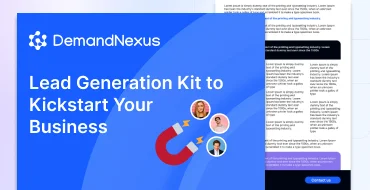We at DemandNexus understand how hard it is to find the right balance between what you want and what you can do. Our tried-and-true methods and tools help sales teams set and reach appointment-setting goals that work, all while keeping team morale and relationships high. This article talks a lot about the art and science of making good goals for setting appointments. It gives you helpful frameworks, tips, and information on how DemandNexus can help you change your sales funnel.
Why It’s Important to Set Goals for Appointments
Setting appointment goals is like giving your sales team a compass that shows them how to get meetings with qualified leads. The number of appointments made, the quality of leads engaged, and the percentage of meetings that lead to sales opportunities are some of the metrics that these goals include. If done right, they do more than just fill up calendars. They help you build long-lasting relationships with potential clients, make your sales pipeline work better, and increase conversions.
But if you don’t set clear goals, you might waste time, lose interest, and get a lot of leads that aren’t good. Michael Maximoff, Managing Partner at Belkins, says, “Chasing unrealistic goals can lead to serious burnout and shallow conversations, which can hurt long-term results.” You can avoid these problems with DemandNexus by making sure your goals are strategic, measurable, and in line with your business goals.
Setting clear goals for appointments has its advantages.
- Sales that work better: To get the most out of your money, focus on leads with a lot of potential.
- Better Relationships: Talk to the people who make decisions in a way that matters.
- Streamlined Pipeline: Make sure that the funnel keeps bringing in qualified leads.
- Why the Team Should Be Motivated: Salespeople stay interested and work hard when they have realistic goals.
- More Changes: Good appointments lead to better close rates.
Making good and bad goals for appointments
Not every goal is the same. Goals based on quantity often put volume over value, which makes outreach less effective and frustrates teams. Quality-driven goals, on the other hand, are based on results that are in line with your business’s long-term goals. This is a comparison:
| Bad Examples (Quantity-Based) | Good Examples (Quality-Driven) |
|---|---|
| Make 20 appointments every day. | This quarter, set up 10% more meetings with qualified leads. |
| Make sure that every meeting lasts at least half an hour. | Increase the number of appointments that turn into sales by 15% in six months. |
| Get everyone to sign up. | This quarter, 75% of your meetings should be with people who fit our ICP. |
Bad goals are often not realistic or don’t have anything to do with actual sales results. This makes teams focus on numbers instead of quality. Setting good goals based on data from the past and your Ideal Customer Profile (ICP) will help you make real progress and grow over time.
How to Make Plans That Work for Appointments
You need a plan to set appointment goals that work. Using proven frameworks and data-driven insights can help you make sure your goals are both big and doable. These frameworks are used by DemandNexus in our services to help you set goals that work with your sales plan.
1. Use the SMART Framework
The SMART framework makes sure that goals are Time-Bound, Measurable, Achievable, Relevant, and Specific. This method helps your team stay on track by giving them clear, measurable goals that matter.
- Specific: Try to get 10 healthcare decision-makers to meet with you every week.
- Measurable: Keep track of the number of appointments made and the conversion rates to make sure they can be measured.
- Achievable: Make goals based on what the team can do and what has happened in the past.
- Relevant: Make sure that what you do is in line with your goal of getting better in the healthcare field.
- Time-Bound: Finish it in the next three months.
Example: “Increase qualified appointments by 20% over the next quarter, with 80% of meetings involving decision-makers in the tech and healthcare industries.”
2. Use the OKR Framework
The Objectives and Key Results (OKR) framework makes sure that your goals are clear and can be measured, so they are both big and possible.
For instance:
- Goal: This quarter, it should be easier to make appointments.
- Key Results:
- Every sales rep should get 30% more appointments every week.
- 15% more of the qualified leads that turn into sales.
- Cut the time between the first contact and the appointment by 25%.
3. Use the WOOP Model
WOOP (Wish, Outcome, Obstacle, Plan) is a framework that helps you plan for problems and figure out how to solve them. It’s great for working in sales settings that are hard to deal with.
For instance:
- Wish: Get good appointments with people who make important decisions.
- Outcome: Meeting once a month made it 40% easier to close deals.
- Obstacle: Prospects are unsure because the value propositions aren’t clear.
- Plan: Use case studies from the industry to make targeted outreach.
4. Use KPIs
Key Performance Indicators (KPIs) are numbers that you can measure to see how well you’re doing. To make sure your KPIs are realistic, compare them to industry standards (for example, SDRs usually set 23.1 appointments a month) and the data you have from the past.
Some examples of KPIs are:
- How many appointments do you make each week?
- The percentage of leads that become appointments.
- The percentage of people who don’t show up for meetings they set up.
What makes DemandNexus the best choice
At DemandNexus, we don’t just help you set appointment goals; we also give you the tools you need to reach them quickly and accurately. Our all-in-one approach uses the newest technology, personalized plans, and a personal touch to get results that feel real and make a difference. This is why we are the best partner:
- Advanced Technology: Our appointment-setting platform automatically schedules appointments, sends email reminders, and puts high-potential leads at the top of the list. This cuts down on no-shows and makes things run more smoothly.
- Multi-Channel Outreach: We use cold calls, emails, and LinkedIn messages to reach out to potential customers in a way that makes it easy for them to respond. Look at our plans for generating leads on LinkedIn.
- Data-Driven Insights: We use CRM and BI tools to keep track of KPIs like CPA and conversion rates and set realistic goals based on how things have gone in the past.
- Personalized Communication: Our team writes messages that connect with your ICP and build trust, which leads to more meetings.
- Help from Professionals: We train your SDRs from the start and keep training them so that they are in line with your B2B sales strategy.
- Focus on Closing: We can handle the hard work of setting goals, reaching out, and optimizing, so your sales team can focus on what they do best: closing deals.
How to Make the Most of Your Appointment Setting Goals
Once you’ve set your goals, these best practices will help you reach them:
- Quality should come before quantity
Instead of going after a lot of bad leads, make sure to set up meetings with people who fit your ideal customer profile (ICP). How to Qualify B2B Leads explains this method, which increases the number of leads that turn into customers. - Check out old information
Set realistic goals based on how well you did in the past, such as the average number of appointments set or the number of people who didn’t show up. DemandNexus’s analytics tools make this process simple. - Do Outreach Personal
Cold Calling Tips says to call and email people who are having specific problems. Personalization makes more people come to appointments and talk to you. - Take advantage of automation
You can use DemandNexus’s platform to automate things you do all the time, like setting up appointments and following up. This lets your team focus on the most important things. - Build a strong sales team
Pay for training and give your SDRs bonuses based on how well they do to keep them motivated. Our guide on Sales Development Representative Roles has advice on how to build a team that works well together. - Make your value proposition better
Make it clear how your product will help people who might want to buy it. This will make it easier to set up meetings. - Follow Up the Right Way
As we talked about in B2B Appointment Setting, you should make a plan for how to follow up with people so that they remember you but don’t feel like you’re pushing them.
Important Metrics to Keep an Eye On to Measure Success
To make sure you stay on track to reach your appointment-setting goals, keep an eye on these KPIs:
- Total Number of Meetings: Planned for each week or month.
- Conversion Rate: The number of appointments that turn into leads for sales.
- No-Show Rate: The percentage of meetings that prospects don’t show up to.
- Cost Per Appointment (CPA): The average cost of getting each meeting.
- Time to Appointment: The amount of time it takes to make an appointment after the first contact.
You can use DemandNexus’s analytics tools to get real-time information about these metrics. This lets you make changes based on data to improve performance.
In conclusion, DemandNexus helps you get more done.
It’s not just about hitting numbers when you set good appointment setting goals. You also need to make a plan that leads to real connections and growth over time. Using frameworks like SMART, OKR, and WOOP and putting quality ahead of quantity can help your sales team do better. When you work with DemandNexus, you’ll get the tools, information, and support you need to set and reach goals that will change the way you sell.
Are you ready to make your appointment setting better? Go to DemandNexus to learn how we can help you schedule more high-quality meetings and close more deals.
Questions and Answers
What are the goals of making appointments?
Goals that help your sales team set up meetings with qualified leads, based on metrics like the number of appointments set and the conversion rate.
Why is it better to make fewer but better appointments?
Goals that focus on quality make sure you meet with prospects who have a lot of potential. This cuts down on burnout and increases conversions.
How can DemandNexus help you set up meetings?
DemandNexus gives you automated tools, personalized outreach, and information-based insights to help you set and reach your goals.
What are the best ways to make goals for appointments?
There are a number of frameworks that have been shown to work for setting realistic and measurable goals. These include SMART, OKR, and WOOP.
How can you tell if you are good at making appointments?
Watch KPIs like the number of appointments made, the conversion rate, the no-show rate, and the cost per appointment (CPA).



